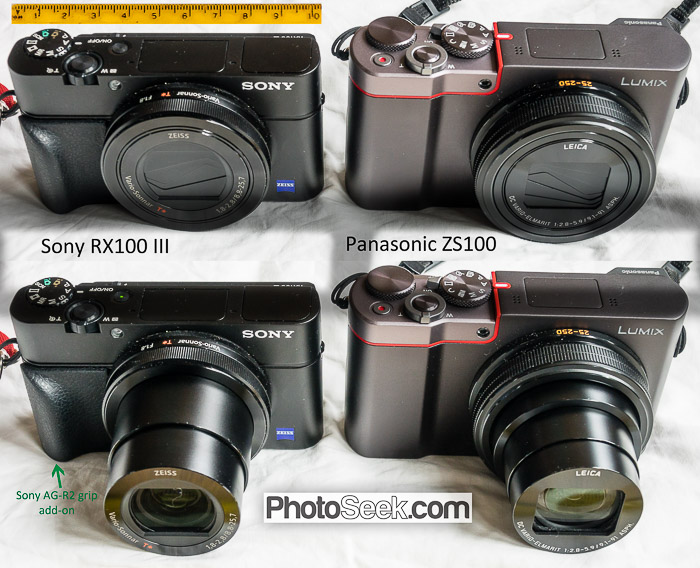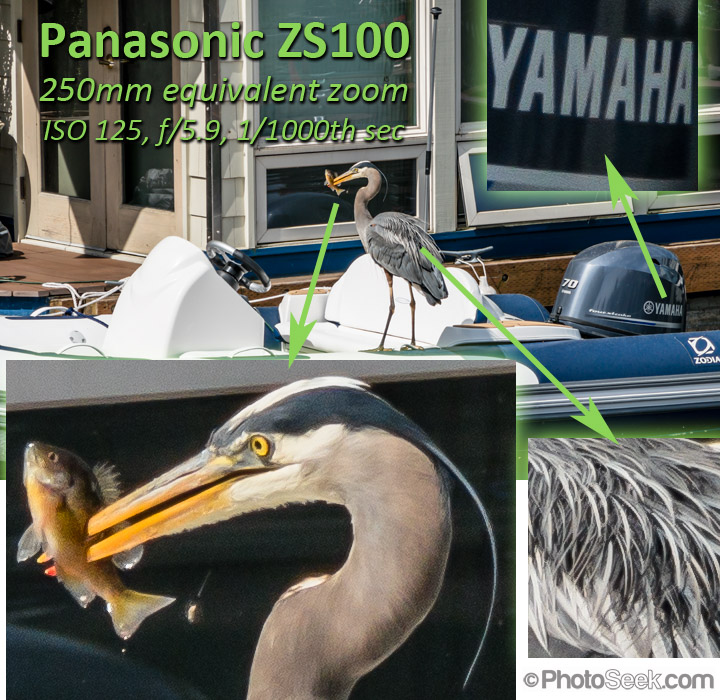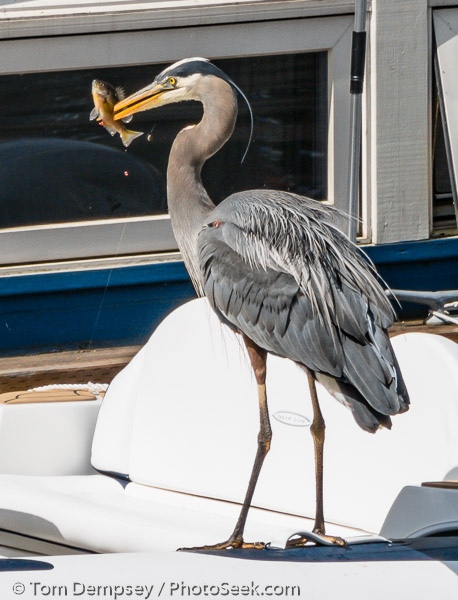In 2016, the most portable 10x zoom on a 1-inch-Type sensor is Panasonic LUMIX ZS100 camera (Amazon) (11 oz, 25-250mm equivalent). ZS100 is now my favorite camera which can fit a large shirt pocket. In this impressive 2016 feat of miniaturization, daylight image quality from the 20-megapixel ZS100 can rival all of my cameras used over 34 years until 2012 (beating my cameras up to 4 times heavier, up to 11x zoom range, up to 12 megapixels, at base ISO 100).
UPDATE: As of August 2018, Sony introduced the superior RX100 version VI (RX100M6, Amazon) (24-200mm equivalent 8x zoom with relatively fast f/2.8-4.5 lens), which is pricey but clearly beats the lens sharpness and brightness of Panasonic ZS100. If price is no object, RX100 version VI is now the world’s best pocketable travel camera, and Panasonic ZS100 is second best. In April 2018, Panasonic extended its ZS100 with the new 15x zoom Panasonic Lumix DC-ZS200 (buy at Amazon) (12 oz, 24-360mm equivalent lens f/3.3-6.4). The ZS200 viewfinder increases magnification by 15% and resolution by 35% (2.3M dots vs 1.7M for ZS100). CIPA battery life lengthens to 370 minutes (formerly 300). ZS200’s 50% longer zoom reach for wildlife costs a half-stop loss in lens brightness and compromises sharpness. Personally, I’m upgrading to the sharper Sony RX100M6, where I’ll simply crop to extend telephoto beyond 200mm equivalent.
Although rival Sony RX100 (of 2015, read my review) is admittedly sharper throughout 3x zoom, Panasonic ZS100 focuses closer at more zoom settings and enormously extends optical telephoto reach. Anywhere from 3x to 10x zoom (70-250mm equivalent), the ZS100 easily beats digital cropping of Sony RX100’s furthest reach of 70mm in versions III & IV. ZS100’s good telephoto remarkably expands your capture of wildlife and distant small subjects, more sharply than pocketable rivals or smartphones (see heron photo further below). Portrait photographers should note that ZS100’s lens is a bit dimmer, f/2.8-5.9 at widest aperture as you zoom (versus f/1.8-2.8 for RX100 III).

Compare body sizes:
- 102 x 58 x 41 mm (4.02 x 2.28 x 1.61″) Sony RX100 versions III and IV
- 111 x 65 x 44 mm (4.37 x 2.56 x 1.73″) Panasonic ZS100
Related reading: why larger sensors can improve image quality.
Panasonic ZS100 beats macro focus of Sony RX100
ZS100 captures best macro (close focus) when zoomed by 2x, near 44mm equivalent, to minimize excessive corner softness seen at wider angles of view. You must first press the Macro (Flower symbol/left toggle) button to focus closest. In contrast, Sony RX100 III focuses closest only at 24mm equivalent (widest angle of view), lacks a dedicated macro mode, and cannot enlarge subjects as much. Panasonic ZS100 can enlarge small subjects more sharply than Sony RX100.
Because macro was one of my main reasons for carrying an RX100 (to supplement a larger-sensor APS-C system with 11x zoom which captured poor macro), a ZS100 now serves better as our backup travel camera for my wife to carry.
Surprisingly good telephoto sharpness
Carrying a pocket camera with 10x zoom around town lets me capture unexpected moments like this at a distance:

The above overall image (originally 20 megapixels, 5472 x 3648) can be cropped to isolate the heron at 1764 x 1348 pixels, which is enough to print sharply about 7″ high (at 250dpi). Much better than a smartphone camera, Panasonic ZS100 gives you lots of leeway to share digitally cropped telephoto shots on the internet, as in the example below shrunk to 600 pixels high:

Just wanted to say thanks, as I’m looking to replace an RX-100 III with one of these, for the extra reach. Makes it a more desirable hiking camera to get closer shots of wildlife, which has been frustrating with the short reach of the RX-100 III for me. I also don’t want to spend the $$$ for the M6 version, which could be a future upgrade down the line (when used prices are under $500 :)
Question from Rhett Z. on Oct 7, 2017:
Hi Tom, …I was rather pleased to find someone who had put cameras through actual field testing to compare AND spelled out the results online for others to read. So thank you for that and your willingness (within reason) to field questions from others here – looking for advice on which camera to purchase. I am an amateur landscape photographer. My previous three digital cameras were canon semi-manual point and shoots: Canon A520, A540, SX130 IS. …I haven’t really tried to market my photography, but may want to at some point. Right now, my photography is for me to enjoy as large prints on my wall (>= 20×24), computer screen, and the former Panoramio/google maps (…for web viewing). Portability is fairly important to me – the Sony RX100 series is good for that, but has virtually no zoom (and they are fairly pricey for what one gets??).
The Panasonic ZS100 caught my eye in that it has a decent enough zoom and bells and whistles (and you also rated it well). The Sony RX10 series seem impressive – as you noted in your review, but a little pricey and bulky for portability (but maybe not a deal breaker). I like the concept of the backlit and stacked sensor Sony has…. Roughly 50% of my photos are at wide angle (5mm), 3% are 12x (60mm), and everything else in between on the SX130 (1/2.3″). I’m not into macros, birding, or high-speed photography, so extreme telephoto, close ups, and continuous fps are not a priority. I would like 2160p video for playback….
I had a chat with a veteran photographer …and he showed me a 1.3 MP 30×36 print of a parrot. I was blown away by the detail of such an old digital camera! He said much more of the output of the image is a function of the printer itself than the camera, and what the viewer expects to see. So that makes me think about whether cameras are overhyped for their capabilities. Granted, I can imagine that old 1.3 MP would have difficulty in low light and contrasting situations. Nonetheless, after what point do diminishing returns on spending more for a camera become apparent for someone who wants the capability for fairly large prints with little chromatic aberration, good dynamic range in color and detail, but not necessarily marketing the photography at the Jackson Hole photo gallery?
Is the RX10 series significantly better than the RX100 series and ZS100? …is there much difference in image and video quality between the RX100 models 3,4,5? The RX10 models 2,3,4? To finish this up, I’m leaning towards the Sony and Panasonic cameras (maybe also considering Panasonic FZ1000 and FZ2500 – also a little bulky for backpack traveling like the RX10 series)…. Post-processing in Photoshop etc. seems to work wonders for digital photography, but somehow that feels like cheating. At the same time, the cameras themselves do their own pos-processing if not shot in RAW – the latter which needs its own post-processing either way! How much does the camera quality really matter nowadays? I greatly appreciate your time and feedback.
Tom Dempsey replied:
– The pocketable Panasonic ZS100, which I own as a portable backup, may meet your needs well. Its has the same desirable BSI sensor as in Sony RX100 versions II and III (“back-illuminated Exmor R CMOS” is also known as a “High Sensitivity MOS Sensor”). In bright light, ZS100 actually equals or beats my larger main cameras used through 2012. Its wide angle quality is only about 10% less sharp than Sony RX100 models; yet is superior at tele, from 3x to 10x zoom.
– The much bulkier Sony RX10 series may be up to 30% sharper resolution, and has better lens contrast, for sharp prints potentially 30% larger. Yet successful enlargements depend on many factors (such as viewing distance and compelling subject), as in your 1.3 MP example, making camera choice somewhat arbitrary at some point. Sony RX10 IV, and RX100 IV and V, have unprecedented autofocus speed, and improved video.
– Video quality is less sensitive to sensor size than stills, as its resolution is smaller per frame. But to review video quality of each camera, which varies measurably, read sites like dpreview.com:
https://m.dpreview.com/reviews/power-zoom-panasonic-lumix-dmc-zs100-tz100-review/4
https://m.dpreview.com/reviews/sony-cybershot-dsc-rx100-v-review/7
– Note that ND filter is only helpful on bright sunny days to allow slower exposures to blur waterfalls, or for video to have shallower depth of focus at brightest f-stop (which is not very shallow in small sensors such as these 1 inch, and smaller).
– Post-processing is not cheating; instead, it’s essential to match your human perceptions, which an automated camera JPEG rendition rarely fully captures. Raw allows the most leeway adjusting tones, highly recommended and always used by me. Gosh, I have been using various cameras for nature travel 39 years now, and lately cameras keep improving significantly every 2-3 years. Happy travels!
Rhett replied:
You mention its capabilities relative to cameras through 2012; the ZS100 was announced early 2016. Is such a comparison fair to compare older cameras to a newer one?
I just read a review by Jim Fisher of PC magazine from April of this year who says this of the ZS100:
You suggest otherwise apparently in your review of the ZS100?
If you had a choice only between the best of the RX100 (V?) vs the ZS100, which would you choose, assuming 75% of your shots are only up to ~3x zoom…, neglecting any price difference of up to a few hundred dollars?
The Panasonic LX100 also caught by eye with its larger 4/3 sensor (but only 3x zoom), and the LX10 which has a 1″ sensor but also BSI (and only 3x zoom). Am I just splitting hairs in this camera category? Thanks again!
Tom replied:
– The Panasonic LX100 only has 12.8 MP, which is outmoded by 20MP cameras with BSI, which helps balance the sensor size difference, confirmed comparing studio shots at 100% pixel size.
– Shooting raw, which expands recoverable dynamic range for editing, I find no need for HDR techniques or modes.
– The comparison of ZS100 to my 2012 and older cameras is helpful perspective appreciating how quickly camera sensors have improved, shrinking to pocketable size a camera with similar capabilities which were formerly several times larger. Great for backpacking and hiking!
– RX100 V might be worthwhile if you especially value top autofocus speed, action and portraits, and best possible (slightly better) low light, low noise, highest resolution shots, at the cost of radically sacrificing telephoto range.
– But my wife and I now entirely use our ZS100 instead of our RX100 iii, which sits idle. Despite the Fisher quote, in practice, the 10x zoom is immensely practical for us, clearly beating RX100 from 3x to 10x zoom, versus cropping. Not much needing shallow depth of focus, we find the less-bright lens mainly means slightly grainier shots at wide angle, not a big impact on print size. I am currently not tempted by the RX100 V upgrade.
Tom, I recently bought a TZ110 (Australian version of the ZS100) for a trip to Canada as backup to my A6300 + 18-105 and 70-300L I use with an adapter. The IQ is remarkably good for a pocket camera, especially with that useful zoom. In the end, I shot 4400 images with the TZ110 vs only 700 with the A6300. And given the results will mostly display as slideshows on a HDTV with the best ones making it to a book of prints, I’ve decided to exchange my ILC cameras for single lens cameras for future trips.
After reading yours and other reviews of Sony’s RX10iii, I’ve purchased one of those and now determine the future of the A6300. Not jumping into selling it but I can’t see the need to keep both given my photography style.
Thanks for a very useful and thoughtful website!
Love Panasonic (GH3, GX7, FZ300)…. [and the ZS100 featuring a 1.2-million dot EVF] …is good to know, and I will be taking a closer look at this camera. My main use is shooting actions shots (and video) of surfers at distances of several hundred yards; also birds in flight and the occasional landscape or seascape. This little camera would be the best camera in the world (because I would have it with me) on many occasions. Does it have the usual Panasonic sensor crop (for added reach with no resampling) feature? On the FZ300, this extends the effective zoom from 600mm to 735mm. Thanks for a very nice website – the practical nature of the evaluations and comparisons is very valuable and all too rare.
I like that ZS100’s EVF is always available (and doesn’t need to be popped up and down as with Sony RX100 III or IV).
If you shoot JPEG, try turning on ZS100’s “Intelligent Resolution i.Zoom” feature, giving up to 2x Digital Zoom with “limited deterioration of picture quality” (which supposedly works better than upsizing a crop to 20mp), which would zoom up to 500mm equivalent, JPEG-only (not available when shooting raw file format). I’m not sure if i.Zoom for a JPEG works any better than enlarging an optimized crop from raw file, but Panasonic must have included it for a reason. Personally, I always shoot raw for superior exposure recovery and sharpness optimization; and i.Zoom isn’t available when shooting raw. Turning on i.Zoom may be better than using ZS100’s ordinary 4x Digital Zoom (where enlarging a subset of the sensor’s area to full 20mp decreases picture quality).
Another form of zoom is the same as cropping in an editor: the ZS100’s “Extended optical zoom” uses respectively smaller JPEG EX Picture Sizes, up to 20x zoom in effect, if shooting JPEG (not raw). Personally, I don’t recommend using EX JPEG sizes, since using the full 20 megapixels is much more flexible, and you can easily crop as needed later in an editor.
For a camera which fits in your pocket, Panasonic ZS100 is currently the best all-around option, especially if you like telephoto. It’s my wife’s latest travel camera, and serves as backup for me. “The best camera is the one you have with you.” If you can go larger, Panasonic FZ1000 would capture better images due to larger lens diameter. Better yet (but relatively bulky and heavy, 37 ounces) is my Sony RX10 III with 24-600mm equivalent telephoto. — Tom Dempsey
BG Davis replies:
Thanks for all the additional information and advice. The reason I like the sensor crop zoom is that I can see the subject much better in the EVF. This AM I was shooting surfers who were several hundred yards out (using GX7 with 100-300mm). The extra reach allowed me to tell who was who and get a much better feel for how the wave was shaping up. I always shoot burst mode so as not to miss the best moments, but still it’s always better to have the feel of the wave as you’re shooting. And you end up with 8mp which isn’t bad. (…including a sample 8MP sensor crop shot with GX7 a few months ago… was hazy with flat light so I did do some levels adjustment and minimal sharpening. Without the extra reach of the sensor crop, I couldn’t tell who was who. If you open the full-size image and magnify, you can count the fingers on the hand, see the facial expression, etc..) For days closer to shore the ZS100 might do a pretty good job and with 20mp to work with the end result of a sensor crop shot should be pretty good. I have never liked all the iZoom-type settings – they may have “minimal” degradation but it seems noticeable to me on the cameras I’ve tried. Again, thanks for a great site.
Tom Dempsey replies:
That’s great that you can still get 8 megapixels at digital zoom (EX JPEG size, not upscaled), which can still make big prints. The ZS100 is sharper than I expected at 250mm equivalent (for such a tiny camera), especially at center, which potentially makes it useful for your sensor crop zoom technique.